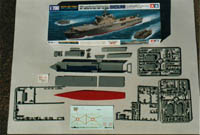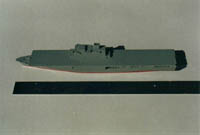| This is a neat little kit by Tamiya, and is a welcome addition by this
company to its waterline range. It is also a modern vessel, having entered
service only a few years ago with the JMSDF. If my memory serves me correctly,
Tamiya have never before produced a modern vessel in their excellent
range of 1:700 waterline ships, and I certainly hope the trend continues.
As the real Ohsumi will evidently be joined eventually by three others
of the same class (at the moment these are either building, fitting out
or have yet to be started) there is potential for Tamiya to get some mileage
out of their moulds! The Ohsumi seems to have a primary role of amphibious army support, being in many ways a miniature version of the USN LHD. The design is in fact based on the Italian San Giorgio amphibious class ships (of which there are three vessels). It is somewhat rather larger than the San Giorgio's but the lines are unmistakably similar and in fact it seems likely that if the modeller desired, a relatively simple (if somewhat expensive) conversion of the Ohsumi could easily result in one of the three Italian vessels. Essentially a small flat top, but by no means an aircraft carrier, most of the 'upper' or 'landing deck' of Ohsumi is given over to two lifts for vehicles, a marshalling/parking area for equipment and vehicles, and a 'landing on' deck for helicopters. The lifts (a small one amidships and a large one forward) service a lower deck where further vehicle and equipment storage occur. Aft of the vehicle section of the 'upper deck' is the landing deck proper, where two Chinook size choppers can load up (apparently simultaneously) with troops, equipment, stores or vehicles. Below this aft section is a fairly generous well deck which services two US designed LCAC hovercraft (the primary means for getting Ohsumi's tanks and other armoured vehicles ashore). A relatively massive 'island', to starboard, dominates the upper deck. Mounted on the island is the primary active defence system - two 20mm CIWS mountings - as well as chaff launchers. On her exterior, Ohsumi is a simple looking vessel, apparently purposely so to reduce radar reflection, though she can in no way be regarded as a state-of-the-art stealthy design. Interestingly, Ohsumi is small; Janes references initially seemed to suggest she marked the return of the Japanese carrier, by commenting she looked like she may one day acquire a ski-jump and therefore some sort of attack aircraft role. Personally, I think there is no way a purposeful weapons carrying VSTOL aircraft could ever effectively utilise that tiny deck area for take-off purposes; I'd suggest the early 'ski-jumping' commentators were mislead by the lower forecastle deck derived from the San Giorgio design, with its provision for a 76mm gun. Ohsumi is a small amphibious warfare vessel that happens to look like a carrier! The Tamiya kit The little kit is quite simple and neat, including a well detailed inner well area, with two miniature LCAC's, a nicely detailed upper deck (two pieces) and forecastle deck (one piece), with lash down points, lift outlines, anchor winches and so on in the usual Tamiya fashion. At the time of writing, I have only begun assembly of the kit but things look promising so far. I will update this review on completion of the model, with additional photography. So far fit of parts is satisfactory, but perhaps not as good as I would have expected - perhaps Tamiya need a little practice after staying away from 1:700 for such a long time (certainly the Tamiya 1:700 WWII USS Indianapolis would be an interesting build too, being rather more complex a subject). The overall level of detail is in my opinion, rather equal to, or perhaps less than the mark set by Pit-Road/Skywave with their polystyrene releases. However, Tamiya seem to have a more realistic level of detail, being more restrained than the sometimes unrealistic high level exhibited by Skywave's kits. Step One In this step, construction of the island or bridge assembly is a straightforward task. The stack, plated mast assembly, and the larger sections of island do however need some attention once glued together; careful sanding down will be required. There is certainly some scope for extra detailing using either commercially available etched brass or finely stretched sprue and thin plastic card (depending on the expense account and/or skill of the individual modeller). Certainly I'll be adding some extra doors, pipes and so on from scrap to bring this section 'more alive'. I'll also use some generic etched brass railings along the edges of the deck and island. Step Two comprises the major hull sub-assemblies. The usual Tamiya metal weight is provided if desired, recessed pieces for Ohsumi's boats are fitted at this stage, and the interior (!) of the well deck is fitted at this time (when was the last time you fitted a 1:700 scale ship with an interior?). This wonderful feature will allow super detailers to go to town, though I have little reference on the well interior and would be very interested in finding some (are there any Japanese modellers who could help here, or perhaps anyone who may have some magazines other readers can have a look at?) Incidentally, a reasonable link to exterior photos of the ship are as follows: Click here In this step, I found fit of parts ,so far, to be good. Certainly, little filling and sanding will be required, what there is will be no big deal. Watch the floor of the rear well area in the main hull part; there are recessed ejection pin indentations all around it. Though not a highly visible area, they need to be removed if you wish to draw your admirers attention to this zone. The rear ramp for the LCACs and amphibious vehicles (if in fact the JSGDF have any) is also fitted at this point. The ramp alone has nine parts associated with the door, hinges and actuating pistons. Watch part A4 as it also has some ejection pin indentations moulded on the inner surface; these should be filled and sanded to remove them. Interestingly, it seems to be Tamiya's intention that the door can be made to operate, and with a little fiddling, this may well be the case! You have to omit the pistons, or modify them at least, and once attached the whole door structure could be a little fiddly and vulnerable. On the other hand, if you like working parts on your models… Moving right along, the usual red waterline plate, which fits fairly neatly onto the hull comes last, and then it's on to: Step Three which is the final assembly phase, prior to exterior painting and detailing. Keep in mind Ohsumi is a very simple looking, rather bland vessel in real life (check the link above). The two LCACs, construction of which is covered in this step, will help provide some extra interest in a potential diorama setting. One has ramps up in travelling mode, and one with ramps down, in loading/unloading mode (in fact with both it's ramps down, it is probably quite clearly in LOADING mode). For more info, and reference on what looks like a camouflage scheme on the Japanese LCACs, see: Photos Also provided are two JGDSF CH-47 Chinooks (yes they are Army, not Air Force: you can tell by the camouflage!) These also liven up the ship, and though I'll replace the three bladed rotors offered with 10 thou card examples as those that are supplied are overscale kit items, they are nice little replicas in there own right. While on the subject, much also can also be done to increase the interest level of your Ohsumi by putting scratchbuilt vehicles on the forward area of the upper deck, adjacent the 'island'. Skywave/Pit-Road 1:700 WWII vehicle sets, with some modification, may assist here, though some simple scratchbuilt softskin vehicles and wheeled APC/armoured cars would be relatively easy. You could also try the 1:700 armour and soft skins supplied in the 1:700 Dragon Tarawa class LHDs, or the similarly scaled Dragon Russian amphibious assault/hovercraft set. The LCACs themselves are candidates for some extra detail. In real life these are rather complicated looking machines, and the simple five part replicas don't really do them justice. Tamiya have, I think done a creditable job, but I think the average modeller could do a lot more and at the same time make the model Ohsumi look a whole lot more interesting. More on this anon… Now we get to final assembly time. The completed island is mounted on the upper deck, along with some finely detailed life raft containers, some fittings, the anchors and the ship's boats. Colours and Decals Tamiya maintain that the overall colour is 'Haze Grey'. Now while I think fresh US Navy 'Haze Grey' is kind of similar to faded and worn Japanese Navy grey, my observations have been that Japanese ships are invariably a rather darker shade of grey than that on US ships. Accordingly I used a dark shade of grey on my Ohsumi. Tamiya maintain that the horizontal upper decks region forward of the 'landing on' deck should also be 'Haze Grey'; again I disagree. It definitely looks a different colour in photos I've seen to date, so I'll be painting it several shades darker than the vertical surfaces 'modern Japanese Navy Grey'. The flight deck is specified as 'Light Grey'. If this is a Tamiya paint description, it may well be right, but I don't use Tamiya paints. My Humbrol colour will again be a shade or two darker than the rest of the horizontal deck colour used. The decal sheet supplied seems quite comprehensive, though further comments on its quality and application will have to wait until I start applying them. They certainly liven up the subject with their colour; you even get interior well-deck markings! Conclusions Thus far I am thoroughly happy with this neat little kit. Tamiya have done a good job with a ship the Japanese are deservedly quite proud of. As the model is completed, I will submit more photos to update this review, and I may add to my comments above. However, I can recommend this one very highly, and I look forward to further Tamiya modern naval releases. My thanks to SMML for the supply of the review kit. |

